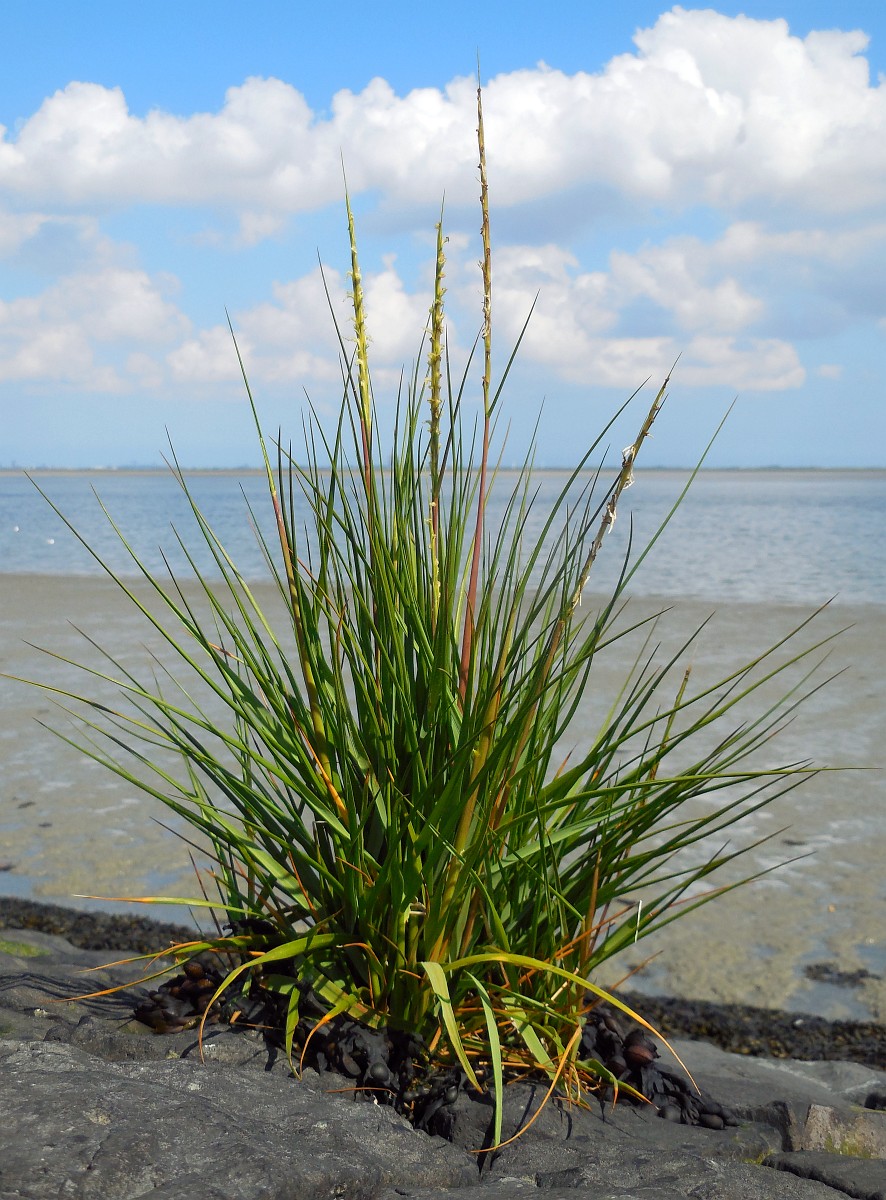Cordgrass identification and control
Information about the noxious weed cordgrass. Cordgrass is also known by its Latin name, Spartina.
About this weed
Cordgrass is a regulated Class A noxious weed. This means eradication is required state-wide. Cordgrass is also on the Washington quarantine list.
Common cordgrass is known as Spartina anglica and it is in the grass family. There are currently four species of cordgrass on the King County weed list, but common cordgrass was historically found in King County and will be focused on. These other cordgrasses are dense-flowered cordgrass (S. densiflora), saltmeadow cordgrass (S. patens), and smooth cordgrass (S. alterniflora). All are regulated Class A noxious weeds.
Also please note that the name ‘Spartina’ (spar-tie-nuh) is used very commonly, probably more than the name ‘cordgrass’.

Why it's a problem
Cordgrass displaces native species and destroys wildlife habitat for animals including shellfish, salmon/fish, and birds. As a byproduct of its habitat destruction, it also interferes with recreational activities. It is one of the most aggressive and fastest spreading plants worldwide. Once established, cordgrass can be very difficult and costly to control. Left unchecked it will convert estuaries into meadows.
Plant description
Common cordgrass is a salt marsh grass, originally native to Northern Europe. It grows 1 to 4 feet tall and has upright flowers that appear in late summer.




Be aware of look-alike plants
Spartina identification can be difficult even for trained professionals. As of 2022, there are no known infestations of cordgrass in King County, so quickly identifying and controlling any plants is important. Cordgrass can look like many other salt marsh grasses, so, if possible, please send well-lit, focused pictures of the flowering parts, the top and bottom surface of leaves, and the habitat for most accurate results.
When in doubt, take photos and share them with us or report them on iNaturalist.
What to do if you find it
Property owners are required to control cordgrass on lands that they manage. Please notify us if you see cordgrass growing in King County. Our program staff can provide the property owner or appropriate public agency with site-specific advice on how best to remove it. We map all known locations of regulated noxious weeds such as cordgrass in order to help us and others locate new infestations in time to control them.
Control methods
We recommend using a combination of methods to control noxious weeds. In areas with few weeds, it is important to act quickly before they become harder to manage. Make a long-term plan as it often takes several years to get rid of most weeds. Start in the least infested areas first and then move into more heavily infested areas.
Manual Control
Young plants can be pulled, remove all the root and plant. Remove entire plant from tidal zone. Multiple visits per season are recommended. Earlier is better, pulling or digging large plants is difficult and can be ineffective. If seeds are present, clip off seedheads, and dispose of them in the garbage. Mowing can be effective, but only if done repeatedly. Start in spring when they first appear and continue until they die off in fall. Do not allow seeds to grow.
Chemical Control
Stay safe when using herbicide:
- Always read the label before use.
- Wear a long-sleeved shirt, long pants, shoes, and eye protection.
- Follow state and local regulations.
Treat plants in mid-summer through early fall. Non-selective herbicide is required. Imazapyr and/or glyphosate-based products recommended. If seeds are present, clip off seedheads, and dispose of them in the garbage.
See the PNW Pest Management Handbook for the most up to date and specific method for chemical control of cordgrass.
Avoid spraying where there is a chance that herbicide will enter a waterway or wetland unless you are using a state-approved aquatic herbicide and have the required permits and licenses to do so. Use of pesticides in water is regulated in Washington state. See Washington Department of Ecology Aquatic Pesticide Permits for details.
For more information or a site-specific control recommendation in King County, contact the noxious weed program. For information in other counties in Washington state, contact your local weed board or your local cooperative extension office.
Disposal instructions
Because Spartina grows in tidal zones, it can be difficult to dispose of. If pulling the plants, the entire plant and surrounding sediment must be removed, so it is only recommended for small infestations. Pulled plants must be brought away from the tidal zone to prevent resprouting.
All reproductive parts (flowers, seeds, and roots) should be put in garbage bags and disposed of as trash or taken to the transfer station.
Another option is to allow the plant parts to dry out. First, remove any flowers or seeds present. You can then lay the rest of the plant parts on a tarp, or a raft made from woody debris. The most important thing to be careful about is that the roots cannot touch the soil, as plants can regrow from old root fragments.
Washington State Noxious Weed Control Board pamphlet on noxious weed disposal

 Translate
Translate